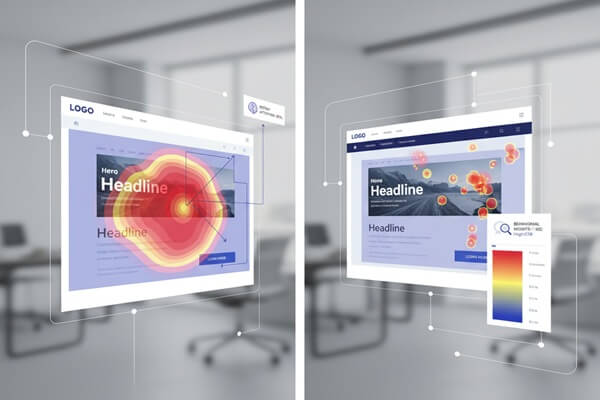
Understanding how users interact with digital content is crucial for optimizing user experience (UX) and advertising performance. Traditional methods like click-tracking and scroll maps offer behavioral data, but they often miss the critical first seconds of exposure, when attention is formed and visual hierarchies are processed. This is where predictive AI heatmaps come into play, offering designers, marketers, and UX professionals an advanced tool to forecast where users are most likely to focus without relying on live participants.
Predictive Attention and AI Heatmaps in UX
A leading AI heatmap tool for UX leverages predictive eye-tracking to visualize instant attention—typically within the first 2–3 seconds of visual exposure. Unlike live eye-tracking, which measures actual gaze patterns, predictive models generate heatmaps and gazeplots based on computational saliency models trained on extensive datasets. This process allows teams to anticipate user focus on critical elements such as logos, CTAs, headlines, or navigation menus. By combining object and text recognition, AI-driven heatmaps ensure that key brand elements are positioned in high-attention zones, improving the likelihood of recall and engagement.
Enhancing Visual Hierarchy and UX Clarity
Visual hierarchy plays a pivotal role in how users scan and interpret content. Predictive heatmaps identify areas of clutter and clarity, helping UX designers prioritize elements that should capture attention first. For example, a well-structured gazeplot might reveal the natural order users follow: logo → core message → call-to-action. Simplifying visual hotspots enhances cognitive processing and ensures that important elements are noticed immediately. Tools that generate predictive clarity scores provide a benchmark for comparing design variations, allowing data-backed decisions that reduce guesswork in UX optimization.
Advertising Pre-Testing and Benchmarking
Predictive AI heatmaps are particularly useful in advertising pre-testing. By assessing attention scores, marketers can gauge whether creatives are likely to capture interest within the crucial first few seconds. Research suggests that higher attention scores (≥65) can correlate with significant increases in CTR, offering quantifiable insights into ad effectiveness before launch. Additionally, benchmarking allows teams to compare designs against peer data within the same channel, identifying performance gaps and opportunities for refinement.
Integrating Predictive and Behavioral Insights
While predictive eye-tracking forecasts instant attention, combining these insights with click and scroll heatmaps provides a fuller picture of user behavior. Predictive outputs indicate likely visual focus, while interaction heatmaps capture real engagement. Together, these layers of data inform better UX and CRO strategies, ensuring that both design clarity and functional performance align with user expectations.
Conclusion
AI heatmaps transform the way brands and designers understand user behavior by mapping attention before live testing. By focusing on instant attention, visual hierarchy, and object/text recognition, predictive eye-tracking enables more precise UX optimizations, ad pre-testing, and benchmark comparisons. Integrating these predictive insights with actual behavioral data empowers teams to make informed, efficient decisions that enhance usability and maximize engagement.


